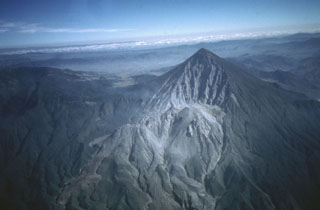Report on Santa Maria (Guatemala) — 28 May-3 June 2025
Smithsonian Institution / US Geological Survey
Weekly Volcanic Activity Report, 28 May-3 June 2025
Managing Editor: Sally Sennert.
Please cite this report as:
Global Volcanism Program, 2025. Report on Santa Maria (Guatemala) (Sennert, S, ed.). Weekly Volcanic Activity Report, 28 May-3 June 2025. Smithsonian Institution and US Geological Survey.
Santa Maria
Guatemala
14.757°N, 91.552°W; summit elev. 3745 m
All times are local (unless otherwise noted)
The Instituto Nacional de Sismología, Vulcanología, Meteorología e Hidrología (INSIVUMEH) reported high levels of ongoing eruptive activity at Santa Maria’s Santiaguito dome complex during 27 May-3 June with continuing lava extrusion at Caliente dome. Daily weak and moderate explosions, as many as three per hour when reported, generated gas-and-ash plumes that rose as high as 1 km above the dome and drifted as far as 40 km in various directions. Effusion of blocky lava and collapses of material produced block avalanches that descended multiple flanks; the collapsed material sometimes produced short pyroclastic flows that reached the base of Caliente cone. Incandescence was visible at Caliente dome and upper part of the SW flank lava flow. Ashfall was reported in areas downwind including San Marcos (10 km SW), Loma Linda (7 km W), Palajunoj (17 km SSW), Finca Monte Bello (6 km WSW), and Monte María during 27-31 May.
Geological Summary. Symmetrical, forest-covered Santa María volcano is part of a chain of large stratovolcanoes that rise above the Pacific coastal plain of Guatemala. The sharp-topped, conical profile is cut on the SW flank by a 1.5-km-wide crater. The oval-shaped crater extends from just below the summit to the lower flank, and was formed during a catastrophic eruption in 1902. The renowned Plinian eruption of 1902 that devastated much of SW Guatemala followed a long repose period after construction of the large basaltic andesite stratovolcano. The massive dacitic Santiaguito lava-dome complex has been growing at the base of the 1902 crater since 1922. Compound dome growth at Santiaguito has occurred episodically from four vents, with activity progressing E towards the most recent, Caliente. Dome growth has been accompanied by almost continuous minor explosions, with periodic lava extrusion, larger explosions, pyroclastic flows, and lahars.
Source: Instituto Nacional de Sismologia, Vulcanologia, Meteorologia, e Hidrologia (INSIVUMEH)

